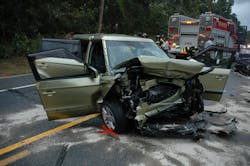The number of trucks involved in fatal accidents was up 3% in 2016 from 2015, according to a recent report from the Federal Motor Carrier Safety Administration.
In 73% of those crashes, there was some form of encroachment — another vehicle, person, animal or object — in the truck driver’s lane.
While I know we will never get to zero when it comes to accidents involving commercial vehicles, I think reviewing the statistics helps us focus on what the trucking industry can do to make the roads as safe as possible.
Trucking industry manufacturers and suppliers need to continue to develop trucks and components that enhance safety. We need to do more work on things like collision mitigation systems, lane departure warning systems, etc. Then fleets need to have those installed on their vehicles so we begin with vehicles that are as safe as they can be.
But technology alone is not the answer. The next step is to develop a culture of safety at each and every fleet. From the highest level of the organization, fleet owners and managers must spread the gospel of safety throughout their organizations. This has to include ongoing driver training, not just training during onboarding, but safety training throughout the year.
It also includes training dispatchers so that they do not pressure drivers to make deliveries in unrealistic time frames, which would require the driver to violate traffic laws.
Shippers too must have realistic expectations of delivery times and must also take steps to avoid detaining drivers at their facilities, which will erode drivers’ hours of service and therefore put pressure on drivers to make deliveries before they run out of driving hours.
As industry participants, we also have to educate the motoring public about how their actions impact safety on the road. We have to let them know about stopping distances and blind spots and how what they do can mean the difference between a safe ride and an accident.
Safety is the responsibility of everyone in the trucking industry. Reviewing FMCSA’s report is a good place to start and provides us with a jumping off point for conversations on what each of us can do to make the roads safer for everyone.
About the Author
Jane Clark
Senior VP of Operations
Jane Clark is the senior vice president of operations for NationaLease. Prior to joining NationaLease, Jane served as the area vice president for Randstad, one of the nation’s largest recruitment agencies, and before that, she served in management posts with QPS Companies, Pro Staff, and Manpower, Inc.
